Korfball drills for technique condition / strength
- Player A starts in front of the post with a shot until he/she scores.
- After a goal to next point.
- If missing; run back and forth to previous spot and shoot where you missed.
- Finish the round.
- This can also be done without running up and down.
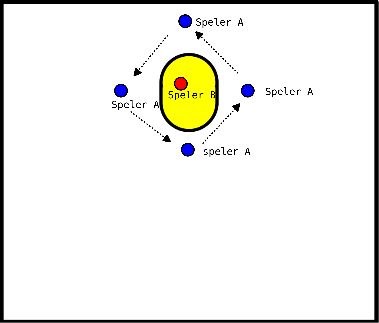
- Player A starts with the ball 2.5 meters diagonally in front of the post. Player B also stands 2.5 meters diagonally in front of the post.
- Player A throws the ball to player B and player B throws it back. Thus they bring the ball up to about 8 meters in front of the post.
- From there, player B starts for a through ball from the space indicated by player A.
- However, instead of player B taking the through ball, it now enters the declarer and player A comes in for a clearance ball. Player B catches the ball.
A variation on this:
Only throw the ball when player B runs next to/behind the basket and player B immediately makes a shot. Player A immediately runs in to catch the ball.
Only throw the ball when player B runs next to/behind the basket and player B immediately makes a shot. Player A immediately runs in to catch the ball.
There are more variations on this, such as:
- Most goals in a time frame of, say, 10 minutes
- Who scores 10 goals first
- Make it more difficult by deducting a point for each ball on the ground.
- Possibly with a 3rd player to rotate and keep a slightly slower pace.
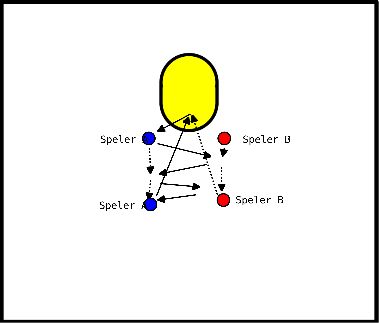
- Player A starts with the ball 2.5 meters diagonally in front of the post.
- Player B also stands 2.5 meters diagonally in front of the post.
- Player A throws the ball to player B and player B throws it back.
- Thus they bring the ball up to about 8 meters in front of the post.
- From there player B starts for a through ball from the space indicated by player A.
- Player A also runs in after it to catch the ball before it bounces on the ground.
Variations:
- Most goals in a 10-minute time frame.
- Whoever gets to 10 goals first.
- Make it harder by taking a point off every ball on the ground.
- Possibly with a 3rd person there to rotate through and keep a slightly slower pace.
- Most goals in a 10-minute time frame.
- Whoever gets to 10 goals first.
- Make it harder by taking a point off every ball on the ground.
- Possibly with a 3rd person there to rotate through and keep a slightly slower pace.
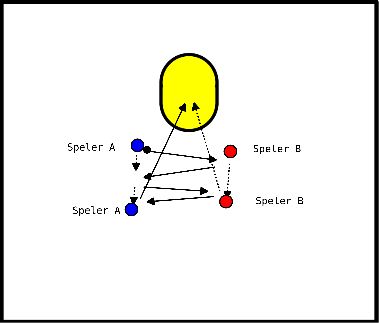
- Per person, everyone must score 10 through balls, this goes in groups of 3 or 4.
- In case of a miss, the whole group goes to the other side of the field on pace run and back.
- The one who missed takes the chance again.
- Until 10 are scored per player.
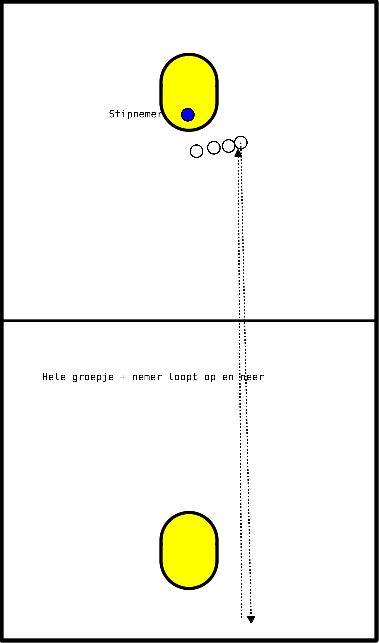
- White throws to blue and blue passes to red.
- Blue goes for the breakthrough and gets it to red.
- Blue shoots and catches himself. White goes to blue's position.
- Blue plays the ball to red, who passes to white, then breaks through and gets the ball from white.
- Blue and red switch positions and so on.
- 20x scoring.
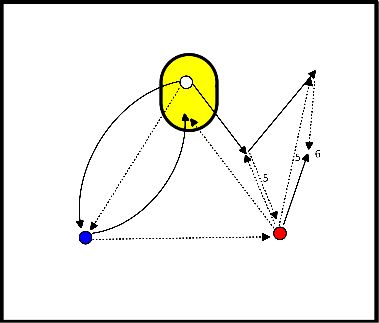
1.Sprint to the hat in front of you, place your foot next to it, make a turn and sprint to the next hat and so around the box. 4x
2. You keep looking in the same direction at all times. You sprint forward, then backward as fast as you can to the first hat.
Then sideways right and back and then sideways left and back. 3x
2. You keep looking in the same direction at all times. You sprint forward, then backward as fast as you can to the first hat.
Then sideways right and back and then sideways left and back. 3x
3. Forward to right, sideways to left and backwards to starting point. 2x clockwise and 2x counterclockwise.
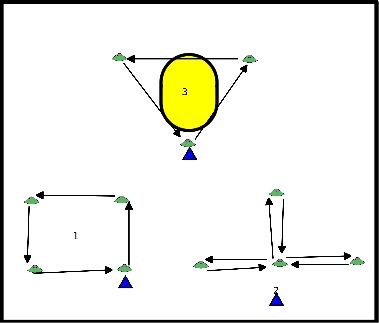
- For the example, I assume 6 / 7 players.
- On a line the length of the field there are 3 poles spaced about 7 meters apart.
- At each pole stands 1 player with ball.
- First the remaining players walk past all the posts and take a through ball everywhere.
- Repeat this 3 times and then switch positions.
- The next round are dodge balls to the left.
- The next round dodge balls to the right.
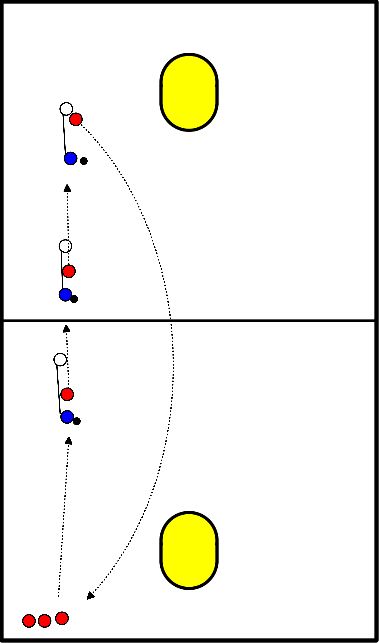
- At trainer's signal, both players start sprinting.
- Blue must run around first pawn and Red runs straight through to tap Blue.
- Red becomes Blue and flips over.
Objective:
The base is a standard running form exercise, where you have players move back and forth in different ways to train general motor skills.
The tap game element adds responsiveness by having players react as quickly as possible and determine what they are going to do.
The tap game element adds responsiveness by having players react as quickly as possible and determine what they are going to do.
Description:
- The players stand on a line and are given a way by the trainer to run across each time, see also running forms.
- All players have a ribbon on, 1-3 players with the same color.
Occasionally, while walking back and forth, the trainer calls out the color of 1 of the ribbons. These then become the tickers. The tickers get 10 seconds to tap as many of the remaining players as possible. - Then all return to the same line and start a running form again.
- The idea is to start the tagging round immediately when the trainer calls a color and to quickly start the next running form when the tagging round is over. Keep up the pace.
Variations:
Instead of running forms where players walk back and forth, you can do movement exercises standing in the same spot. Examples include Jumping Jacks, sitting/lying and getting up again, jumping forward and backward, etc.
The trainer occasionally gives the next movement assignment and calls a color to start a tap round.
Running Forms:
Standard
- Running / Running backwards
- Hopping / Hopping backwards
- Sideways with front right / Sideways with front left
- Small steps
- Hopping on right / Hopping on left
- Cross pass
Jumps
- Jumps as large as possible.
- Medium-sized jumps and always balancing on 1 foot for a while before taking the next jump.
- With two feet side by side.
- With two feet side by side a big jump forward and another small jump back.
- With two feet zigzagging.
Arm movements to be combined with the above forms.
- Swing 1 arm forward or backward.
- Swing both arms forward, or both backward.
- 1 arm forward and 1 arm backward.
- Holding another body part with 1 or both arms.
As animals
- Frog; jumping on hands and feet.
- Crab; on hands and feet, with belly up.
- Kangaroo; jumping on two legs.
- Flamingo; hopping.
- Duck; crouching walk.
The trainer occasionally gives the next movement assignment and calls a color to start a tap round.
Running Forms:
Standard
- Running / Running backwards
- Hopping / Hopping backwards
- Sideways with front right / Sideways with front left
- Small steps
- Hopping on right / Hopping on left
- Cross pass
Jumps
- Jumps as large as possible.
- Medium-sized jumps and always balancing on 1 foot for a while before taking the next jump.
- With two feet side by side.
- With two feet side by side a big jump forward and another small jump back.
- With two feet zigzagging.
Arm movements to be combined with the above forms.
- Swing 1 arm forward or backward.
- Swing both arms forward, or both backward.
- 1 arm forward and 1 arm backward.
- Holding another body part with 1 or both arms.
As animals
- Frog; jumping on hands and feet.
- Crab; on hands and feet, with belly up.
- Kangaroo; jumping on two legs.
- Flamingo; hopping.
- Duck; crouching walk.
- This exercise is designed to let the players choose for themselves what they want to improve on.
- Which (improvement) goal, which they have set for themselves, do they want to improve here.
- As a trainer you can steer this by guiding the choice.
- For example: the exercise must have something to do with passing/shooting/attacking/looking etc.
Jumping exercise with 9 cones.
- You sprint back and forth between 2 cones.
- 30 seconds
- 15 seconds rest
- 30 seconds
- 30 seconds rest
- 30 seconds
- Then take penalty throw directly
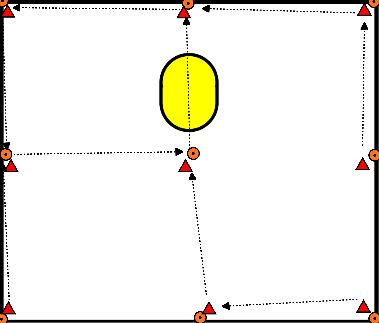
Exercises with speed ladder: agility and coordination exercises. Each exercise 4x
The intention is also to emphasize balance. So use your arms as well.
The intention is also to emphasize balance. So use your arms as well.
- 2 foot contacts per section forward.
- 2 foot contacts per square sideways (only in the ladder).
- Icky shuffle (in-out).
- Icky shuffle backwards.
- In and out (2 feet in, 2 feet spread out from the ladder) explosively.
- 1 foot in-out: start next to the ladder, always in and out, other foot stays out of the ladder in a nice rhythm.
- Sideways in-out the ladder 2 foot contacts.
- Cross-over: move sideways, always bring the 'back' leg in front.
- Sideways through the ladder, changing foot each time you jump.
- Reverse cross-over: about the same as icky-shuffle, but always bring the outer foot back through the ladder.
- Carioca: lateral through the ladder, front to back.
- Like icky-shuffle, but with 2 feet together (out-in-out).
- Same as previous, but now on 1 leg.
- 2 foot contacts per compartment, 2 compartments in front, 1 compartment back.








